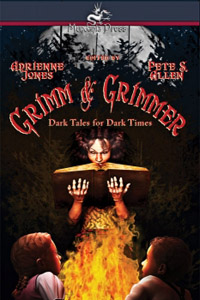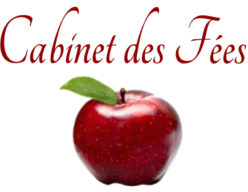Grimm and Grimmer
by Adrienne Jones & Pete S. Allen, 2009
Reviewed by Patricia J. Esposito
 In her introduction to the short story collection Grimm and Grimmer, Adrienne Jones explains that in ancient culture “folktales were the news, the entertainment and the celebrity gossip of the day ‘¦ tales of princesses and wealthy men and horses without fleas; of rags to riches, finding the golden goose.” The old tales showed both the “hardships and heroics” of the times, she says, and this collection was spawned with the idea that modern life isn’t so different.
In her introduction to the short story collection Grimm and Grimmer, Adrienne Jones explains that in ancient culture “folktales were the news, the entertainment and the celebrity gossip of the day ‘¦ tales of princesses and wealthy men and horses without fleas; of rags to riches, finding the golden goose.” The old tales showed both the “hardships and heroics” of the times, she says, and this collection was spawned with the idea that modern life isn’t so different.
I agree, especially after reading the collection. The stories gathered here sometimes have the flavor of the old fairy tales, sometimes are starkly new, but they all resonate with the same moods and themes of a genre that has lasted centuries. What’s here, however, is not the sparkly fairy-dust kinds of stories; these tales hark back to the brothers Grimm and are not what, in this modern day, we tell our children.
The collection covers a range of styles. “Jack My Razorback” by Jake Allen has the feel of a traditional fairy tale, of the Grimm’s variety, with the hardness of farmers and curses of witches set against the vulnerability of a child, deformed, cursed, and in search of love. While the story that follows it, Joel Best’s “Once Upon a Time in Alphabet City” takes the reader to a grungy club on Avenue B, where Pinocchio is “gunning Luckies and knocking down bourbon,” and the blue fairy wears a “shear day-glo blouse and hotpants.”
Some provide lessons like the old tales. Darwyn Jones’s “Betrayal,” offers a hard warning on the damage we can do to our lives as we betray ourselves, and Gary Wolf’s retelling of the three little pigs (with impeccable style capturing the tone of each pig), gets in the huff and the puff, and the various modes of construction, all with more modern truths of greed and bribery. “Rapugnant” by Adrienne Jones takes us immediately into a bar conversation with dubious boasts of a lady – “no scabs. No pox neither. No spots of any kind” – whose golden hair tumbles out a tower window. As in the old tales, we know this teller of tales will goad his friend into the forest and, probably, into danger, and we might have some lessons to learn about listening too receptively to bar talk
Other tales offer hope and redemption. Mike E. Purfield’s “Already There” takes us into a small moment of bliss (related with authentic heart) and then immediate loss, with the wandering, searching fear we all have of death and loss, as well as a surprise ending you’ll want to know. Chris Cox’s tale “Snow White” is a grimier version of redemption, following the heroin-addicted protagonist Snow White. Cox’s writing filters us into the drug-induced state with beautiful accuracy and immediacy, so that we feel the warped halls, and read in a state almost as unbalanced as the characters who walk this world. I’m not sure you want to see the dwarves that Snow envisions here, but Cox includes all the pieces of the original tale, except in a horrifying way that’s as far as you can get from Disney.
One of my favorites is “Agony and Ecstasy Jones” by Aurelio O’Brien – on the one hand a satire of our disorder-labeled society and its miracle drug cures, on the other a family tale that’s not so hard to relate to. O’Brien sets us in a magic world, with potions like Paxil, that somehow made me realize even more how much we appeal to that wish for something to ease our lives, like a drug to get us through, like winning the lottery. I won’t say how, but the ending surprised me and left me grateful.
This is a satisfying collection of thirteen tales (yes, thirteen) for anyone wanting to get back to fairy tales as maybe they were meant to be, and an inspiring collection for those of us who like stories and news of the times dished out with spice, and aren’t afraid to be dealt an occasional lesson with the whip of fear.

